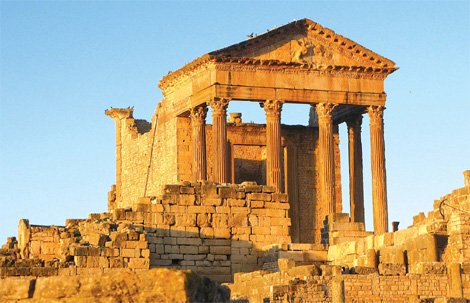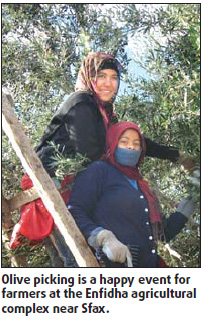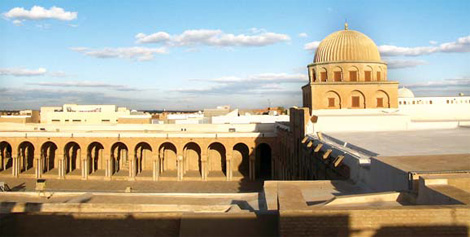

My first visit to an African country, Tunisia, started with surprises. Like many other Chinese, any mention of "Africa" brought to mind images of beautiful grasslands, exotic wildlife and poverty.
But as soon as I arrived at the international airport at Tunis, I found that none of these stereotypes were true.
The people are Arabic, and Tunisia is an open, Islamic country. Only a small number of women in the big cities wear a head scarf, let alone the full-body cover. According to our guide, only South Tunisia has Blacks, a small minority of around 13 percent.
Squashed between Algeria to the west and Libya to the southeast, Tunisia borders the Mediterranean Sea to the north and east, with a coastline extending 1,300 km.
Our week-long tour organized by the International Olive Council included brief stops at north and central Tunisian cities, such as Tunis, Dougga, Hammamet, Sfax, and Sousse.
The country has many sea resorts, while the vast Sahara in the south is also becoming popular as a tour destination, partly owing to the shooting of such films as Star Wars and The English Patient.

Tourism contributed more than 80 percent of the county's GDP in the 1960s, but now accounts for only 7 percent, according to Bochra Malki, an official at the Tunisian External Community Agency. But, long a magnet for Europeans, it does draw 7 million foreign tourists every year.
A small country of just 10 million people, the country has a 3,000-year-long history, with a very diverse cultural background.
The ancient city of Carthage was founded in 814 BC and was such a thriving center of trade and commerce that it attracted the attention of an expanding Roman Empire. After the fall of Carthage in the 2nd century BC came nearly 700 years of Roman rule. Later, the country came under the Vandals, and the Byzantine dynasties, before Islamic conquest in the 7th century AD.
In 1956, the country declared independence from French colonial rule, and was proclaimed a republic. Since then, Tunisia has promoted gender equality, and abolished polygamy. Its stable economic development has won President Ben Ali much popularity, and his portrait can be seen everywhere in the country.
Sidi Bou Said village was definitely a highlight of the tour. This port village reminds one of Santorini in Greece with its beautiful blue and white colors. But it also has unique architectural elements, such as domes and arched doors like those found in a mosque.
Talking of mosques, locals believe that seven visits to the Great Mosque at Kairouan are equal to a pilgrimage to Mecca. Unfortunately, when we arrived there in the afternoon, it was already closed for prayers.
Bardo Museum at Dougga has the world's biggest collection of Roman mosaics. Besides images of ancient gods, many carry scenes of everyday life in ancient times, such as hunting, harvesting, and picking olives.
The museum has the world's largest single mosaic, measuring 130 sq m, named Neptune's Triumph, from the 2nd century AD, showing Neptune on a chariot pulled by four sea horses surrounded by 56 medallions and hexagons representing nereids, tritons and sirens on sea monsters.
At Kalaa Kebira, Mayor Daassa Mohamed welcomed us to the annual international tourism festival, where we not only tasted fresh olive oil, but also saw how it was made.
For those who love shopping, Tunisia is heaven, with a Medina in every city. Medina means old city, but now refers to a shopping district for tourists selling hundreds of products - from jewelry, bronze ware and carpets, to leather, glassware, spices, and sweets, besides numerous souvenirs.
We visited three Medina in Hammamet, Kairouan and, on the last day, in the capital Tunis. The Medina at Hammamet was mostly for tourists, while the one at Kairouan was really a place for the locals. The vendors expect people to bargain and this can be quite an experience.
Those at the Medina of Tunis, for example, used some interesting tactics. One of them told me I looked exactly like a friend of his, and that he would give me a "friend's price". After 10 minutes of bargaining, I bought several small colorful jewelry boxes for my wife as a souvenir, at 4 dinars (22 yuan) each. But I soon found that was a little more expensive than at the next-door, fixed-price store - for the same goods. Another one said to me: "Don't look at the price label, that's a price for capitalists. I'll give you Chinese, friend price."

Chinese people will feel welcome in Tunisia. So many people could say ni hao (hello). But many of them confused me with the Japanese, and greeted me with a konnichiwa. Last year, reportedly, 3,226 Chinese people visited Tunisia.
While Arabic is the official language, French is spoken widely. Basically, one can survive in the country with English, and an occasional bonjour or merci (French for "hello" and "thank you"). That will usually elicit a Salmu 'Alaykum, Arabic for "hello".
It helps to have basic knowledge of the local foods, while ordering at a local restaurant.
We found that to be particularly true while dining at a road-side restaurant in Tunis, just next to the Great Mosque of Zitouna. The cous cous served with fish was the best we had eaten, even though we had been eating cous cous all along. A meal for two, with two bottles of Boga cider, cost just 14 dinars.
Another memorable meal was the one we had at Ksar Ezzit, an organic olive plantation sprawled over 440 hectares. One can pick fresh olives and even make one's own olive oil.
We had our lunch surrounded by the pleasant aroma of fresh olive oil. The spread comprised pumpkin soup, a braised lamb wrapped in paper, with thyme, followed by a pistachio and almond syrup pie, and a mixture of soft, sweet pomegranate, a dried legume, from which a beverage is made, and a prickly pear.
I also loved the food at Dar El Jeld, a popular restaurant set in a traditional house in Tunis Medina. The restaurant presented typical Tunisian foods in a more formal manner. There was lamb, fish, and seafood, delectably stewed or braised, with a variety of herbs, and the strong, pungent harisa chili sauce. The desserts looked very lovely, but were too sweet for the Chinese palate.
It is a pity I did not explore the wild Sahara, the island of Djerba, and El Jem's Coliseum, but hope to make up for it with another trip to Tunisia.